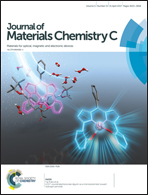Formaldehyde sensing based on the catalytic reaction of β-HgS nanocrystals†
Abstract
We found that β-HgS nanocrystals could catalyze the reactions of oxidase substrates such as 3,3′,5,5′-tetramethylbenzidine (TMB) and O-phenylenediamine (OPD) to form coloured and fluorescent products, respectively, but α-HgS nanocrystals could not catalyze these reactions. Further investigation revealed that the predominantly exposed crystal planes may play an important role in determining the catalytic activity. On the basis of these findings, taken together with the reaction of forming a Schiff base between the –NH2 group of OPD and the –CHO group of formaldehyde, a novel, simple, and highly selective photoluminescence (PL) sensing platform for detecting formaldehyde could thereby be successfully developed.



 Please wait while we load your content...
Please wait while we load your content...